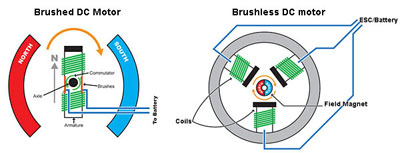
 by Steven D. Johnson
by Steven D. Johnson
Racine, Wisconsin
(Page 2 of 5)
Previous Page
1
2
3
4
5
Next Page
New Tool Technology – Brushless DC Motors
Click on any picture to see a larger version.
Having admitted (freely) to a predisposition to early adoption of new technologies, and also admitted that being at the front of the tech wave can sometimes produce disappointing results, I should not be so quick to rave about Brushless DC electric motors. However, this "new" technology isn't really that new (thus it is a little safer to rave). Brushless DC motors, or BLDCs, as they are commonly known, have been available on a relatively widespread basis since the mid-1960s, but they were quite expensive (compared to "brushed" motors). Since BLDCs typically use solid-state electronics to invert the power and provide phase switching, the rapidly declining cost of microprocessor control circuits has made the BLDC an increasingly cost effective motor.
There are numerous advantages to BLDCs. In many conventional electric motors, the windings of the armature rotate within the body of the motor. In a BLDC the windings are fixed and supported by the housing of the motor and can thus be cooled through conduction rather than by airflow. This alone is a huge advantage for woodworking applications since the housing can be easily sealed from dust.
Also, with the windings fixed to the motor housing and not attached to the rotor of the motor, centrifugal forces are reduced, thereby increasing the efficiency of the motor and reducing wear. And since the motor is powered and controlled electronically rather than through mechanical brushes in contact with the commutator, there is no wear and need to periodically replace brushes. There is also no friction/drag due to this mechanical connection, further enhancing the efficiency of the motor.

|
Figure 2 - This simplified diagram demonstrates the difference between
a "brushed" and a "brushless" motor"
|
Without the mechanical brush-to-commutator connection, there are also no ionizing sparks and there is a significant reduction in emitted electromagnetic interference (EMI). Due in large part to the reduction in EMI, BLDC motors see widespread use as cooling fans in computers and other sensitive electronic gear.
BLDCs win in a heads-up competition when compared to brushed-type motors when comparing torque to weight ratios, ability to precisely control speeds, stopping, and starting functions (i.e. "stepper" motors in hard disk drives, so-called electronic braking, etc.), in power consumption efficiency (more torque per watt), lower noise levels, longer lifespan, and they boast no maintenance cost (no brushes to replace).
Given these significant advantages, it is easy to see why manufacturers have been rushing to put BLDCs in rechargeable power tools. Combining battery improvements and motor improvements, rechargeable electric tools have, in many areas, completely replaced corded electric tools. The market for rechargeable drills now dwarfs the market for plug-in drills. In the case of gardening tools, cordless rechargeable technology has reached the point that for many homeowners, a gasoline-powered mower, blower, or weed whacker is antiquated overkill. All this product development (and sales success) is having another welcomed impact… the price of the technology is coming down steadily.
Within months, not years, there will not be a rechargeable power tool on the market with a conventional brushed motor… they will all be powered by BLDCs. Like the now-largely-abandoned nickel cadmium (NiCad) battery technology, a brushed-type electric motor in a rechargeable tool will be relegated to the dust heap of history.
With the numerous advantages of BLDCs, it was inevitable that sooner or later tool manufacturers would take a look at using them in "corded" power tools. When I spent a month or so using the
Mirka DEROS Electric Random Orbit Sander
, the things that impressed me the most were the incredible weight advantage, the small size, the significant power output, the "quietness" of the tool, the extremely low vibration, and best of all, the quick stop when the motor switch was released… every one of these benefits come as a direct result of the company's use of BLDCs.
So what is next? Will a brushless DC motor show up in a table saw, jointer, or planer? I would say that is unlikely, at least in the near future. In a rechargeable tool the high power-to-weight ratio and low overall electrical consumption is a huge advantage, but in a large stationary tool plugged into a wall outlet, those advantages are largely moot for all but the most ardent greenie. Anyway, as mechanical loads increase, the gap in power efficiency between brushless and brushed motors starts to narrow significantly… at least right now. While the ability to seal the motor from dust is an advantage, there are plenty of large sealed conventional electric motors on the market.
Instead, look for BLDCs to start to show up in other "corded" hand-held power tools… like routers. I, for one, would love it if a manufacturer could shave a couple of pounds off the weight and a few decibels off the sound level of my hand-held routers by using a BLDC. Circular saws and jigsaws are natural candidates for a motor upgrade as well. Technology marches on, and we woodworkers sometimes reap the benefits…
(Page 2 of 5)
Previous Page
1
2
3
4
5
Next Page
Return to
Wood News
front page

